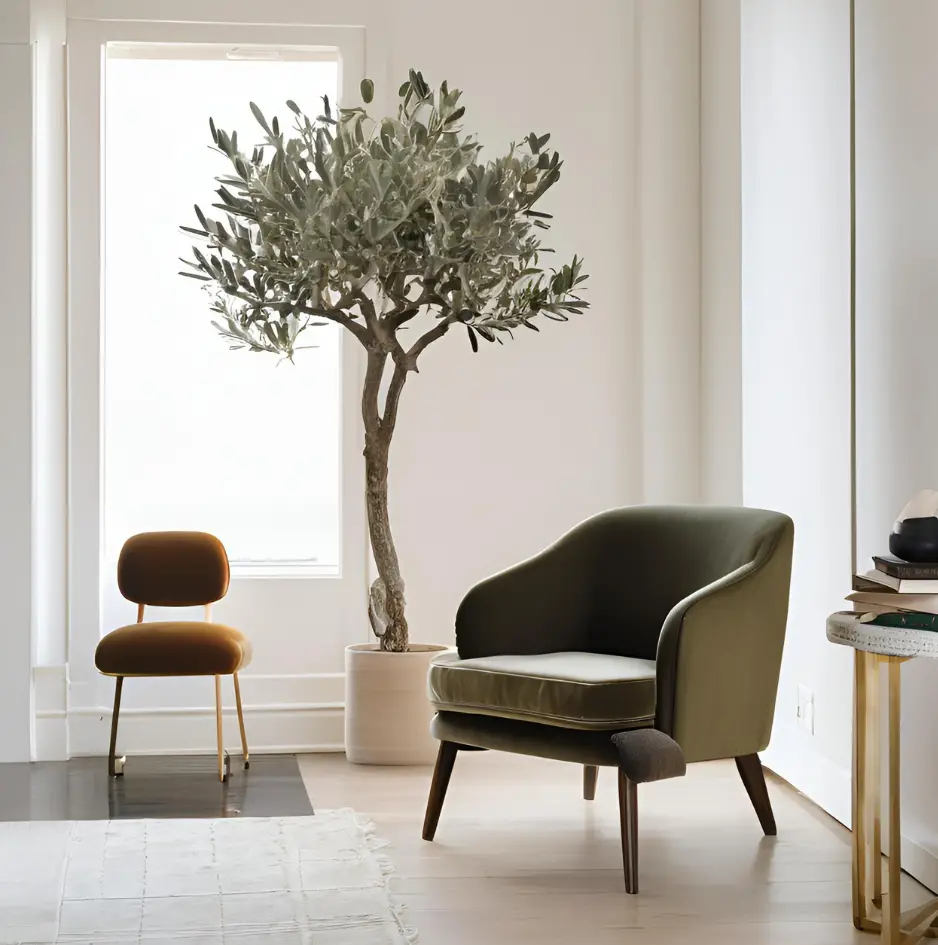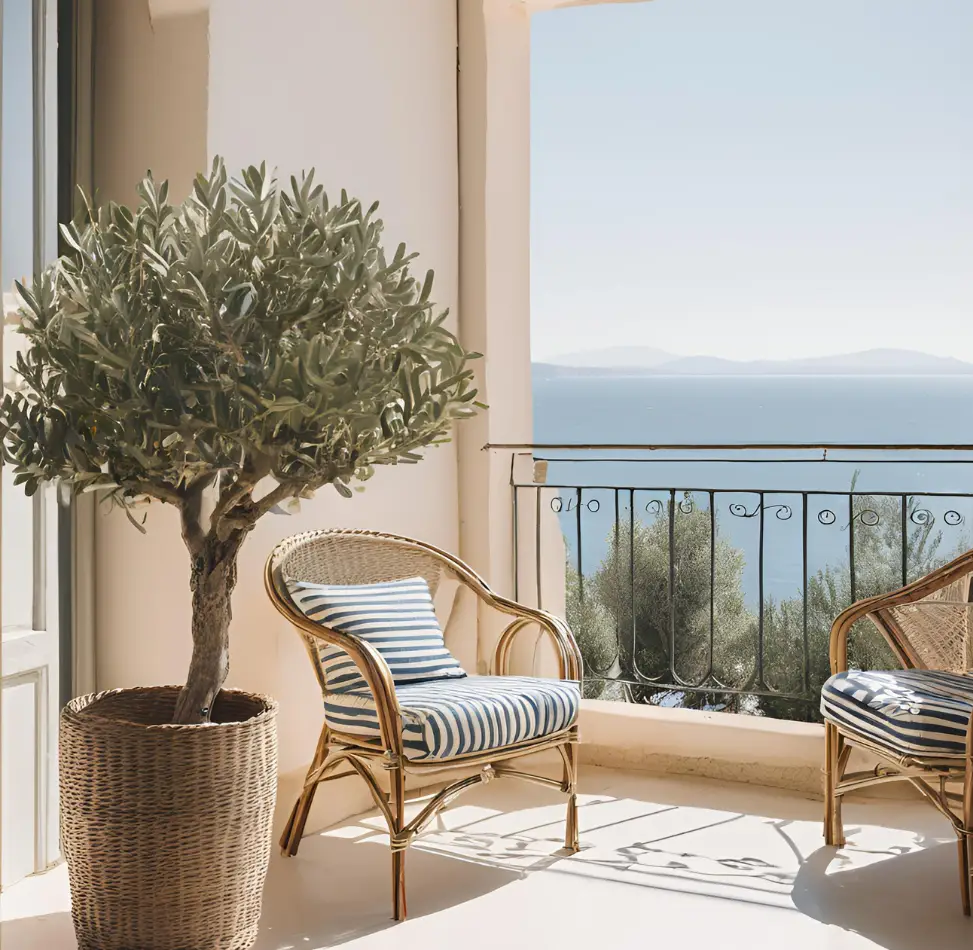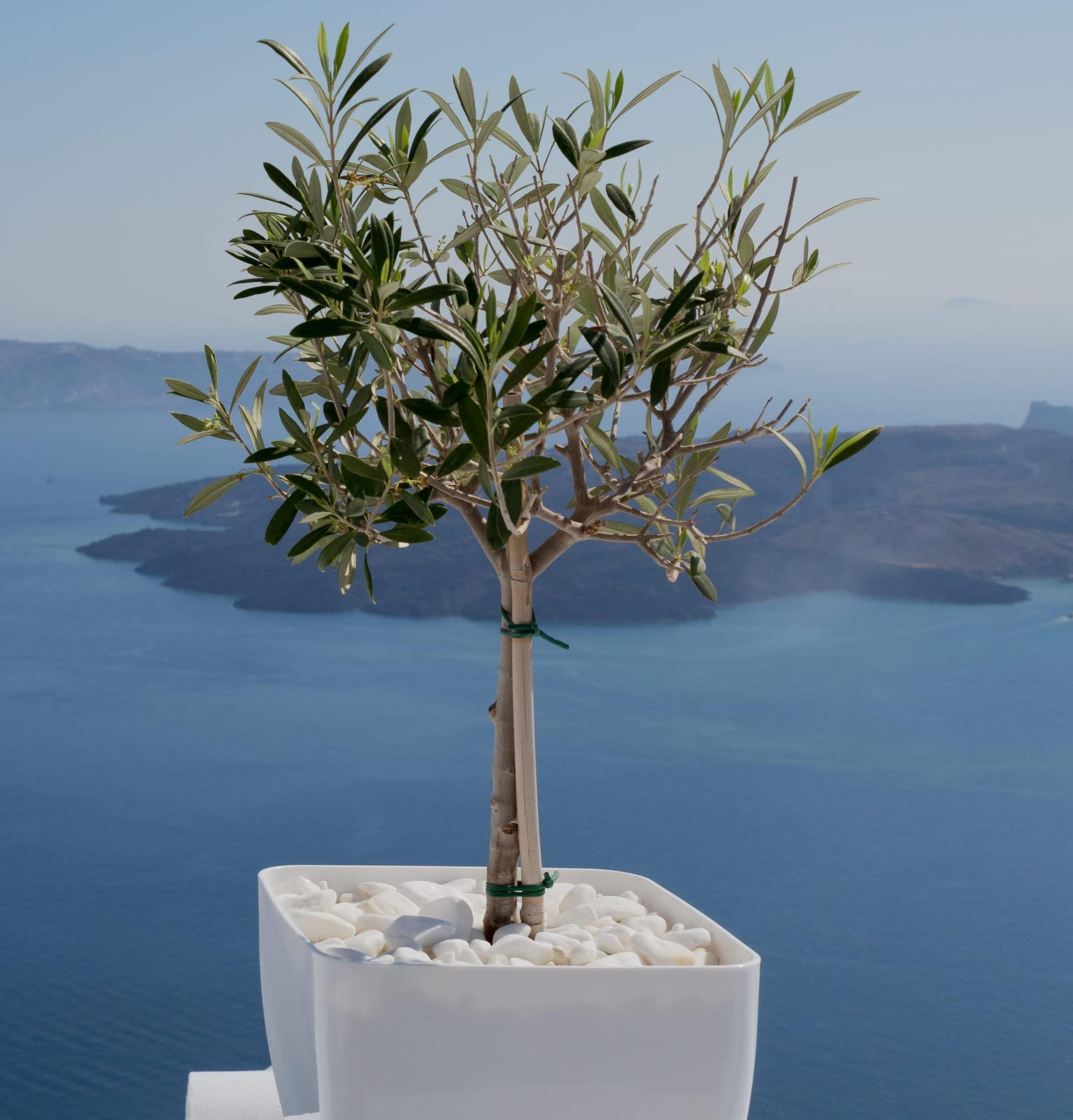The Olive Tree: How to Grow It Indoors or Outdoors

Olive trees can not only be grown in Mediterranean regions like the French Riviera. With the right care, you can bring their timeless beauty into your home or garden, no matter where you live.
Why you should get an Olive Tree
Olive trees aren’t just plants—they’re a piece of living art. With their silvery-green leaves and beautifully twisted trunks, they instantly add a touch of elegance to any space. Symbolizing peace, longevity, and resilience, olive trees have been cherished for centuries across the Mediterranean, not only for their beauty but for the sense of history they carry.
Olive trees blend seamlessly into both modern and rustic spaces. Indoors, they pair perfectly with neutral tones while adding a calming, organic vibe. Outdoors, their sculptural form make them a showstopper in gardens, patios, or courtyards.
How fast do olive trees grow?
Olive trees are slow growers, typically adding 12–24 inches per year under ideal conditions. Their steady pace is part of their charm, allowing them to develop their iconic twisted trunks and elegant form over time.
Can olive trees survive indoors long-term?
Yes, olive trees can thrive indoors long-term if given the right care. They need plenty of bright, direct sunlight—at least six hours a day—and proper watering to prevent overwatering or drying out.
Do all olive trees produce fruit?
Not all olive trees produce fruit, especially when grown indoors or in non-Mediterranean climates. Even fruit-bearing varieties may need specific conditions to produce olives.
How long do olive trees live?
Olive trees are among the longest-living plants, with many surviving for hundreds—and even thousands—of years. With proper care, a potted or garden-planted olive tree can live for decades
Caring for an Olive Tree Indoors

If you successfully want to grow an olive tree indoors, the key is to replicate the sunny, well-drained conditions these trees typically thrive on. Here’s what you need to know:
1. Sun Exposure
Light is essential for indoor olive trees, and they need at least six hours of direct sunlight daily to stay healthy. The best spot for your tree is near a bright south- or west-facing window where it can soak up the sun. If your home doesn’t get enough natural light, a grow light can make a big difference. Without adequate light, your tree might grow spindly, and its leaves could start to drop.
2. Temperatures
Olive trees thrive in moderate indoor temperatures, ideally between 65°F and 80°F (18°C to 27°C). They prefer a relatively dry environment, so avoid humid spaces like bathrooms. During winter, make sure to protect your tree from cold drafts and heating vents, as sudden temperature changes can stress it.
3. Watering
When it comes to watering, less is more. Olive trees don’t like soggy roots, so let the top few inches of soil dry out before watering again. Depending on your home’s climate, this might mean watering every 10 to 14 days. Always use a pot with drainage holes to prevent water from pooling at the roots, as overwatering is one of the most common issues for indoor olive trees.

4. The right Pot and Soil
Olive trees thrive in well-draining soil, so choose a potting mix designed for Mediterranean plants or amend standard soil with sand or perlite for better drainage. A terracotta pot is a great choice—it’s breathable and adds a rustic touch to your décor.
5. Pruning
Pruning helps your olive tree stay healthy and encourages fuller growth. Remove any dead or yellowing leaves and trim back leggy branches to maintain its shape. The best time to prune is late winter or early spring, just before the growing season begins. Pruning also conserves the tree’s energy, helping it focus on new, healthy growth.
6. Disease Protection
While indoor olive trees are relatively low-maintenance, they can occasionally attract pests like scale or spider mites. Regularly clean the leaves with a damp cloth to keep them dust-free and check for any signs of pests. If needed, use an organic insecticide to treat the issue. Fertilizing once or twice a year with a balanced, slow-release fertilizer can also prevent nutrient deficiencies.
Sunlight: At least 6 hours of direct sunlight daily; place near a south- or west-facing window.
Temperature: Keep between 65°F–80°F (18°C–27°C); avoid humid areas and temperature extremes.
Watering: Water every 10–14 days, letting the soil dry out between waterings; ensure proper drainage.
Pot and Soil: Use well-draining soil and a terracotta pot; repot every 2–3 years.
Pruning: Prune in late winter or early spring to remove dead leaves and encourage growth.
Maintenance: Clean leaves regularly, check for pests, and fertilize 1–2 times a year.
Caring for an Olive Tree Outdoors

Ooutdoors, Olive Tress thrive in sunny, airy environments making them a great addition to outdoor spaces in mild climates. Whether planted directly in the ground or kept in a pot, this is what you need to take care of:
1. Sun Exposure
Just as indoors, your outdoor olive tree needs a spot that gets at least 6–8 hours of direct sunlight daily. This can be a sunny corner of your garden or a patio with light exposure. Avoid low-lying areas where water may collect, as excess moisture can lead to root rot.
2. Soil
Olive trees are incredibly adaptable to dry, rocky soils and perform best when planted in well-draining soil. If planting directly in the ground, make sure the soil is light, sandy, or loamy. If your garden soil retains too much moisture, amend it with sand or gravel to improve drainage.
3. Watering and Fertilizing
Olive trees are drought-tolerant but need consistent care depending on the season and climate. During the growing season (spring and summer), water every 10–14 days, letting the top few inches of soil dry out. In hotter climates, you may need to water more often, while in cooler months, reduce watering but don’t let the soil dry out completely. For newly planted trees, keep the soil evenly moist in the first year to establish roots. Fertilize once or twice a year in spring and summer with a balanced, slow-release fertilizer to promote healthy growth and vibrant leaves.

4. Pruning
Regular pruning is essential to keep your outdoor olive tree healthy and attractive. Prune your tree in late winter or early spring before new growth begins, removing dead, damaged, or overcrowded branches. Shape the tree to allow sunlight and airflow to reach the inner branches, which will improve overall growth and reduce the risk of disease.
5. Winter Protection
Olive trees are resistent in mild climates but can suffer in areas with harsh winters. If your region experiences freezing temperatures, protect your tree by wrapping the trunk in burlap and covering the soil with mulch to insulate the roots.
At what temperature does an olive tree need winter protection?
Olive trees are hardy in mild climates but need protection when temperatures drop below 20°F (-6°C). Young or potted trees are more vulnerable and should be shielded from frost and freezing conditions.
6. Disease Protection
Outdoor olive trees are relatively pest-resistant but may occasionally face issues like scale insects, olive flies, or fungal infections. Monitor your tree regularly for signs of pests or disease, and address issues promptly using organic sprays or horticultural oils. Proper pruning and maintaining good air circulation can also help prevent problems.
Choosing the Right Olive Tree
When deciding on an olive tree, think about whether it will live indoors or outdoors. For indoor spaces, compact varieties like Arbequina or Picholine are ideal—they’re smaller in size and adapt well to containers. Outdoor trees, such as Kalamata or Koroneiki, thrive in gardens or patios, offering larger canopies and, in the right conditions, the potential to produce olives.
To ensure you’re buying a healthy, high-quality tree, look for vibrant, silvery-green leaves and a sturdy trunk. Avoid trees with signs of pests or yellowing foliage. If possible, buy from a reputable nursery that specializes in Mediterranean plants, as they’ll guide you toward the best variety for your space and climate.
Final Word
Whether indoors or outdoors, a real olive tree is stylish and easy to care for and brings a mediterranean touch to your home or garden. If you give it the conditions it needs, it will thrive for years. Just follow these basic care tips and you will enjoy its charm all year round!
